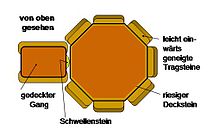Runddysse from Ulstrup
The Runddysse of Ulstrup is located near the confluence of the Ulstrupvej in the Skelbyvej, north of the Skelby Church on the Danish island of Zealand . The megalithic complex from the Neolithic was created by the funnel beaker culture (TBK) between 3500 and 2800 BC. Built in BC.
Neolithic monuments are an expression of the culture and ideology of Neolithic societies. Their origin and function are considered to be the hallmarks of social development. The Ulstrup Round Dolmen is a polygonal dolmen . Its huge capstone is 2.7 m long × 2.0 m wide and 0.95 m thick. Around the complex, which has been robbed of its enclosure, an area of around nine by seven meters has been kept free of agricultural cultivation, within which the rest of the hill has also been preserved.
See also
literature
- Peter V. Glob : prehistoric monuments of Denmark. Wachholtz, Neumünster 1968
Individual evidence
- ↑ Places with this name are not uncommon in Denmark, e.g. B. at Gundeslevholm, also on Zealand
- ^ Johannes Müller : Neolithic Monuments and Neolithic Societies. In: Hans-Jürgen Beier , Erich Claßen, Thomas Doppler, Britta Ramminger (eds.): Varia neolithica VI. Neolithic Monuments and Neolithic Societies. Contributions from the meeting of the Neolithic Working Group during the annual meeting of the North-West German Association for Ancient Research in Schleswig, 9. – 10. October 2007 (= contributions to the prehistory and early history of Central Europe. Vol. 56). Beier & Beran, Langenweißbach 2009, ISBN 978-3-941171-28-2 , pp. 7-16, here p. 15.
- ↑ ( Danish Runddysse ) is the name commonly used in Denmark for dolmens that are located in a round hill. In contrast, dolmens lying in a barren bed are called Langdolmen or Langdysse
Web links
Coordinates: 55 ° 19 ′ 19.6 ″ N , 11 ° 40 ′ 31.6 ″ E

